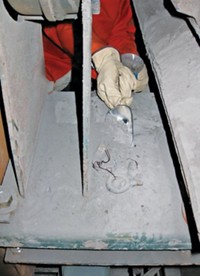Advertisement
Grab your lab coat. Let's get started
Welcome!
Welcome!
Create an account below to get 6 C&EN articles per month, receive newsletters and more - all free.
It seems this is your first time logging in online. Please enter the following information to continue.
As an ACS member you automatically get access to this site. All we need is few more details to create your reading experience.
Not you? Sign in with a different account.
Not you? Sign in with a different account.
ERROR 1
ERROR 1
ERROR 2
ERROR 2
ERROR 2
ERROR 2
ERROR 2
Password and Confirm password must match.
If you have an ACS member number, please enter it here so we can link this account to your membership. (optional)
ERROR 2
ACS values your privacy. By submitting your information, you are gaining access to C&EN and subscribing to our weekly newsletter. We use the information you provide to make your reading experience better, and we will never sell your data to third party members.
Safety
Dust Is Likely Cause Of Deadly Blast
Accident at Georgia sugar refinery raises issue of national dust safety standard
by Jeff Johnson
February 18, 2008
| A version of this story appeared in
Volume 86, Issue 7

Micrometer-size particles of combustible sugar dust are the likely cause of a deadly explosion and fire at a Georgia sugar refinery on Feb. 7, say federal investigators on the scene. The accident killed at least eight workers and injured scores more, and it has renewed concerns over the adequacy of safety standards for thousands of workers in industries that create combustible dust, including some sectors of the chemical industry.
In all, 44 workers were injured in the accident at Imperial Sugar Co. in Port Wentworth, near Savannah. Twenty workers were injured severely enough to merit treatment at burn centers, including 17 who were placed in medically induced comas due to the extent of their injuries.
Seven days after the accident, at C&EN press time, one worker remains missing, and the exact cause of the explosion is unknown because portions of the site are too hot and unstable to allow entry except by rescue and fire personnel, say officials with the Chemical Safety & Hazard Investigation Board (CSB), which dispatched investigators to the scene.
A CSB study released in November 2006 found 281 similar dust explosions between 1980 and 2005 that collectively killed 119 U.S. workers and injured 718. The board's interest in this type of accident ramped up in 2003, when three explosions killed 14 workers in unrelated industries that had the common trait of handling or creating combustible dust. The board study stresses that combustible materials with a particle size of 420 µm or smaller can rapidly react when exposed to oxygen and a source of ignition, causing waves of multiple explosions.
CSB recommended in November 2006 that the Occupational Safety & Health Administration issue a general, comprehensive dust standard as part of its inspection protocols to address hazard assessment, engineering controls, housekeeping, and worker training for a wide range of chemical, rubber, plastics, and metal- and food-processing companies that generate combustible dust. The general standard would be similar to OSHA regulations for the grain industry, issued in 1987 after a series of grain-dust explosions, says Daniel Horowitz, a CSB spokesman.
OSHA, however, did not agree that a dust standard was necessary and instead, late last year, announced a less rigorous "national emphasis program" for combustible dust. The program identifies manufacturers that handle combustible dust, including sugar refiners, but it does not provide specific regulations and standards for the dust. In December 2007, OSHA began increasing training of its compliance officers to look for dust problems when conducting other inspections.
Richard E. Fairfax, OSHA director of enforcement programs, acknowledges that the dust program is less rigorous than the one OSHA uses for grain elevators. He says it grew from a regional program for evaluating combustible dust hazards that OSHA tried in the Philadelphia region. So far, under the emphasis program, OSHA has conducted about 40 inspections of facilities handling combustible dust and issued some citations.
During the next six months to a year, Fairfax says, OSHA will conduct more inspections and evaluate its program to see whether a general standard for combustible dust is needed. He says it is too early to tell whether the Georgia sugar refinery accident will lead to a tougher compliance program as recommended by CSB.
The most recent OSHA inspection of Imperial Sugar was in 2000, and it turned up no problems, according to OSHA officials.





Join the conversation
Contact the reporter
Submit a Letter to the Editor for publication
Engage with us on Twitter